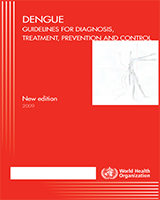All rights reserved. Publications of the World Health Organization can be obtained from WHO Press, World Health Organization, 20 Avenue Appia, 1211 Geneva 27, Switzerland (tel.: +41 22 791 3264; fax: +41 22 791 4857; e-mail: tni.ohw@sredrokoob). Requests for permission to reproduce or translate WHO publications – whether for sale or for noncommercial distribution – should be addressed to WHO Press, at the above address (fax: +41 22 791 4806; e-mail: tni.ohw@snoissimrep).
NCBI Bookshelf. A service of the National Library of Medicine, National Institutes of Health.
Overview
The magnitude of the dengue problem has increased dramatically and has extended geographically to many previously unaffected areas. It remains the most important arthropod-borne viral disease of humans.
This new edition has been produced to make widely available to health practitioners,laboratory personnel, those involved in vector control and other public health officials, a concise source of information of worldwide relevance on dengue.
The guidelines provide updated practical information on the clinical management and delivery of clinical services; vector management and delivery of vector control services; laboratory diagnosis and diagnostic tests; and surveillance, emergency preparedness and response.
Contents
- PREFACE
- METHODOLOGY
- ACKNOWLEDGEMENTS
- ABBREVIATIONS
- 1. EPIDEMIOLOGY, BURDEN OF DISEASE AND TRANSMISSION
- 2. CLINICAL MANAGEMENT AND DELIVERY OF CLINICAL SERVICES
- 3. VECTOR MANAGEMENT AND DELIVERY OF VECTOR CONTROL SERVICES
- 4. LABORATORY DIAGNOSIS AND DIAGNOSTIC TESTS
- 5. SURVEILLANCE, EMERGENCY PREPAREDNESS AND RESPONSE
- 6. NEW AVENUES
A joint publication of the World Health Organization (WHO) and the Special Programme for Research and Training in Tropical Diseases (TDR)
The designations employed and the presentation of the material in this publication do not imply the expression of any opinion whatsoever on the part of the World Health Organization concerning the legal status of any country, territory, city or area or of its authorities, or concerning the delimitation of its frontiers or boundaries. Dotted lines on maps represent approximate border lines for which there may not yet be full agreement.
The mention of specific companies or of certain manufacturers' products does not imply that they are endorsed or recommended by the World Health Organization in preference to others of a similar nature that are not mentioned. Errors and omissions excepted, the names of proprietary products are distinguished by initial capital letters.
All reasonable precautions have been taken by the World Health Organization to verify the information contained in this publication. However, the published material is being distributed without warranty of any kind, either expressed or implied. The responsibility for the interpretation and use of the material lies with the reader. In no event shall the World Health Organization be liable for damages arising from its use.
- NLM CatalogRelated NLM Catalog Entries
- [Toward integrated dengue control ].[Invest Clin. 2002][Toward integrated dengue control ].Valero N. Invest Clin. 2002 Sep; 43(3):141-4.
- Review Emerging and resurging vector-borne diseases.[Annu Rev Entomol. 1999]Review Emerging and resurging vector-borne diseases.Gratz NG. Annu Rev Entomol. 1999; 44:51-75.
- Review [Notes on the laboratory diagnosis of dengue virus].[Rev Cubana Med Trop. 2002]Review [Notes on the laboratory diagnosis of dengue virus].Guzmán MG, Vázquez S. Rev Cubana Med Trop. 2002 Sep-Dec; 54(3):180-8.
- Famine-affected, refugee, and displaced populations: recommendations for public health issues.[MMWR Recomm Rep. 1992]Famine-affected, refugee, and displaced populations: recommendations for public health issues.. MMWR Recomm Rep. 1992 Jul 24; 41(RR-13):1-76.
- Review Dengue - Clinical and public health ramifications.[Aust Fam Physician. 2009]Review Dengue - Clinical and public health ramifications.Esler D. Aust Fam Physician. 2009 Nov; 38(11):876-9.

